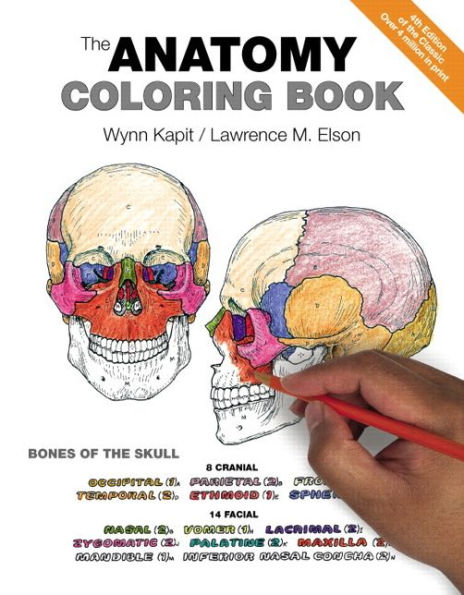Table of Contents
•PREFACE
•ACKNOWLEDGMENTS
•INTRODUCTION TO COLORING
•Anatomic Planes & Sections
•Terms of Position & Direction
•Systems of the Body (1)
•Systems of the Body (2)
•Cavities & Linings
•The Generalized Cell
•Cell Division / Mitosis
•Tissues: Epithelial
•Tissues: Fibrous Connective Tissues
•Tissues: Supporting Connective Tissues
•Tissues: Muscle
•Tissues: Skeletal Muscle Microstructure
•Tissues: Nervous
•Integration of Tissues
•The Integument: Epidermis
•The Integument: Dermis
•Long Bone Structure
•Endochondral Ossification
•Axial / Appendicular Skeleton
•Classification of Joints
•Terms of Movements
•Bones of the Skull (1)
•Bones of the Skull (2)
•Temporomandibular Joint
•Vertebral Column
•Cervical & Thoracic Vertebrae
•Lumbar, Sacral, & Coccygeal Vertebrae
•Bony Thorax
•Upper Limb: Pectoral Girdle & Humerus
•Upper Limb: Glenohumeral (Shoulder) Joint
•Upper Limb: Bones of the Forearm
•Upper Limb: Elbow & Related Joints
•Upper Limb: Bones / Joints of the Wrist & Hand
•Upper Limb: Bones / Joints in Review
•Lower Limb: Hip Bone, Pelvic Girdle, & Pelvis
•Lower Limb: Male & Female Pelves
•Lower Limb: Sacroiliac & Hip Joints
•Lower Limb: Bones of the Thigh & Leg
•Lower Limb: Knee Joint
•Lower Limb: Ankle Joint & Bones of the Foot
•Lower Limb: Bones & Joints in Review
•Introduction to Skeletal Muscle
•Integration of Muscle Action
•Head: Muscles of Facial Expression
•Head: Muscles of Mastication
•Neck: Anterior & Lateral Muscles
•Torso: Deep Muscles of the Back & Posterior Neck
•Torso: Muscles of the Bony Thorax & Posterior Abdominal Wall
•Torso: Muscles of the Anterior Abdominal Wall & Inguinal Region
•Torso: Muscles of the Pelvis
•Torso: Muscles of the Perineum
•Upper Limb: Muscles of Scapular Stabilization
•Upper Limb: Muscles of the Musculotendinous Cuff
•Upper Limb: Movers of the Shoulder Joint
•Upper Limb: Movers of Elbow & Radioulnar Joints
•Upper Limb: Movers of Wrist & Hand Joints
•Upper Limb: Movers of Hand Joints (Intrinsics)
•Upper Limb: Review of Muscles
•Lower Limb: Muscles of the Gluteal Region
•Lower Limb: Muscles of the Posterior Thigh
•Lower Limb: Muscles of the Medial Thigh
•Lower Limb: Muscles of the Anterior Thigh
•Lower Limb: Muscles of the Anterior & Lateral Leg
•Lower Limb: Muscles of the Posterior Leg
•Lower Limb: Muscles of the Foot (Intrinsics)
•Lower Limb: Review of Muscles
•Functional Overview
•Organization
•Functional Classification of Neurons
•Synapses & Neurotransmitters
•Neuromuscular Integration
•Development of the Central Nervous System (CNS)
•Cerebral Hemispheres
•Tracts / Nuclei of Cerebral Hemispheres
•Diencephalon
•Brain Stem / Cerebellum
•Spinal Cord
•Ascending Tracts (Pathways)
•Descending Tracts
•Ventricles of the Brain
•Meninges
•Circulation of Cerebrospinal Fluid (CSF)
•Cranial Nerves
•Spinal Nerves & Nerve Roots
•Spinal Reflexes
•Distribution of Spinal Nerves
•Brachial Plexus & Nerves to the Upper Limb
•Lumber & Sacral Plexuses: Nerves to the Lower Limb
•Dermatomes
•Sensory Receptors
•ANS: Sympathetic Division (1)
•ANS: Sympathetic Division (2)
•ANS: Parasympathetic Division
•Visual System (1)
•Visual System (2)
•Visual System (3)
•Auditory & Vestibular Systems (1)
•Auditory & Vestibular Systems (2)
•Taste & Smell
•Blood & Blood Elements
•Scheme of Blood Circulation
•Blood Vessels
•Mediastinum, Walls, & Coverings of the Heart
•Chambers of the Heart
•Cardiac Conduction System & the ECG
•Coronary Arteries & Cardiac Veins
•Arteries of the Head & Neck
•Arteries of the Brain
•Arteries & Veins of the Upper Limb
•Arteries of the Lower Limb
•Aorta, Branches, & Related Vessels
•Arteries to Gastrointestinal Tract & Related Organs
•Arteries of the Pelvis & Perineum
•Review of Principal Arteries
•Veins of the Head & Neck
•Caval & Azygos Systems
•Veins of the Lower Limb
•Hepatic Portal System
•Review of Principal Veins
•Lymphatic Drainage & Lymphocyte Circulation
•Introduction
•Innate & Adaptive Immunity
•Thymus & Red Marrow
•Spleen
•Lymph Node
•Mucosal Associated Lymphoid Tissue (M.A.L.T.)
•Overview
•External Nose, Nasal Septum, & Nasal Cavity
•Paranasal Air Sinuses
•Pharynx & Larynx
•Lobes & Pleura of the Lungs
•Lower Respiratory Tract
•Mechanism of Respiration
•Overview
•Oral Cavity & Relations
•Anatomy of a Tooth
•Pharynx & Swallowing
•Peritoneum
•Esophagus and Stomach
•Small Intestine
•Large intestine
•Liver
•Biliary System & Pancreas
•Urinary Tract
•Kidneys & Related Retroperitoneal Structures
•Kidney & Ureter
•The Nephron
•Tubular Function & Renal Circulation
•Introduction
•Pituitary Gland & Hypothalamus
•Pituitary Gland & Target Organs
•Thyroid & Parathyroid Glands
•Adrenal (Suprarenal) Glands
•Pancreatic Islets
•Male Reproductive System
•Testis
•Male Urogenital Structures
•Female Reproductive System
•Ovary
•Uterus, Uterine Tubes, & Vagina
•Menstrual Cycle
•Breast (Mammary Gland) BIBLIOGRAPHY AND REFERENCES APPENDIX A: ANSWER KEYS APPENDIX B: INNERVATION OF SKELETAL MUSCLES GLOSSARY INDEX



